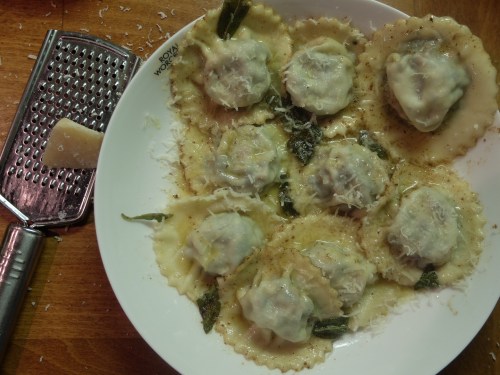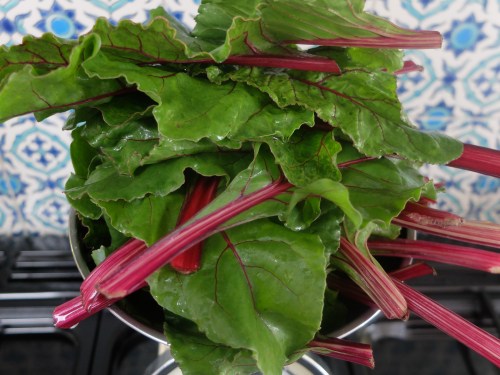
It’s fair to say that there were some doubters in my inner circle when I took on my allotment. The early signs looked likely to prove them right as my garlic rotted, the broad beans got infested with black fly and the slugs and snails rampaged with glee through my emerging seedlings. But, now we’re in the full fling of summer, things are looking good. French beans, runner beans, globe artichokes, onions, courgettes, summer squash, new potatoes and salad are all on the menu, as is the unstoppable rhubarb chard. Although the slugs had only left perhaps six or seven seedlings, they are now the gift that keeps on giving. Relentlessly.

My Italian friend, Elisabetta, makes many amazing creations for her Italian supper club, La Minestra, but her chard and ricotta ravioli is always a winner. Alas, though, she has now returned to Italy for the summer and so I was left to figure it out on my own. The last time I attempted to make ravioli, many years ago, the result was a great deal of swearing and a pan full of floaty bits, so it’s fair to say I (and the rest of the household) was apprehensive. The least I could do was start with some good cheese.

Westcombe Ricotta is made in Somerset, from the whey produced as a result of their cheddar-making. Traditionally fed to pigs or used as a drink, whey is often now seen as a bothersome by-product and, whilst some producers are using it to produce butter, much of it ends up down the drain. The word ‘ricotta’ means ‘re-cooked’; many of us may have concocted a ricotta-type cheese from whole milk in our kitchens but the true cheese is made from whey. Westcombe have been making it since 2011 and it’s much-prized by chefs looking to source quality British produce.
Ingredients (makes 30-40, depending on the size)
500g strong pasta flour (Tipo ’00’)
5 large, free-range eggs
Semolina or plain flour for dusting
600g chard
2 cloves garlic, finely chopped
250g ricotta
150g parmesan, grated
Salt, pepper, nutmeg to season
A handful of sage leaves
50g butter
There are many good explanations of the intricacies of pasta-making – I used Jamie Oliver’s recipe. Make a well in the centre of the flour, crack in the eggs and bring it all together to make a soft, elastic dough. Wrap it in clingfilm and put it into the fridge for an hour.

Meanwhile, remove the stems from the chard and chop very finely. Fry them in a little olive oil with the garlic until soft and then add the chopped chard leaves.

Season and continue to fry until the leaves have wilted. When the mixture is cool enough to handle, squeeze out the excess liquid then finely chop the leaves. Mix with the ricotta and about three-quarters of the parmesan. Season with salt, pepper and nutmeg, to taste.
Roll out your pasta dough into thin sheets, either by hand or using a pasta machine. Put a teaspoon of the ricotta mixture towards the end of one sheet, brush around it with water and place another pasta sheet over the top, smoothing around the mixture to get rid of any air bubbles or creases. Repeat along the length of the sheet. Using a pasta cutter or sharp knife, then cut out the ravioli shapes. Place them on a floured surface until you want to cook them. (Apologies for not taking photos of this process; I was covered in flour and swearing profusely).

When you’re ready to cook the ravioli, heat a big pan of salted water to boiling. Gently spoon the ravioli into the water and cook them on a gentle boil for 3-4 minutes. While they are cooking, melt the butter in a frying pan and add the sage leaves. When the ravioli are ready, take them out of the water with a slotted spoon and add to the melted butter. Swoosh them about until they are covered in the butter and serve warm, sprinkled with the remaining parmesan.
 Depending on the size of your ravioli, one serving should be 6-8 pieces. In the unlikely event there are too many, they can be frozen for future use.
Depending on the size of your ravioli, one serving should be 6-8 pieces. In the unlikely event there are too many, they can be frozen for future use.


Lovely pix. And delicious recipe, my mouth is watering (and I’ve only just had breakfast). I know I say this every time you mention a cheese, but I really must look out for that one. It’s great to have good British versions of overseas classic s.
Thanks. They were very good, although I’m not sure they quite justified the five hours it took to make them…
Making pasta is quite time-consuming. I’m always impressed when people do it unaided as I seem to need a second pair of hands. I expect Elisabetta turns it out in her sleep. 🙂
This sounds a great idea, if VERY time consuming if you don’t have a pasta machine – as I don’t. And I may have to settle for ricotta-from-Italy-off-the-chiller-shelf.
It was very time-consuming WITH a pasta machine! Certainly not what I’d call a ‘quick supper’!
Yes please. These sound soooo good.
All the cheese and butter helped 😉
Wow – what perfectly pretty ravioli! Love sage butter and what a good idea to use chard – another fave of ours. We’ll definitely be giving this a go!
Thank you 🙂 I thought it looked a bit lumpy but it tasted good so I guess that’s the main thing!
Great post, and a delicious sounding recipe!
Thanks! Not sure my allotment efforts can compete with you guys yet but I’m pleased with my first year’s work. We haven’t bought any veggies for three weeks now which feels pretty amazing.
It’s a great feeling, isn’t it? 🙂
It all sounds great..the ricotta, your pasta, and your abundant allotment 😀😀😀
Thank you! 🙂
Ruby chard is one of my favourite veggies. Now I have to try making raviolis again (last time was circa 1981). 🙂
Good luck! It took me most of the afternoon! 🙂
Mouth-watering!
Looks good!
Thank you! They took a very long time to make but did taste great in the end.
Lovely !
Thank you! It was a lot of effort – but worth it in the end.